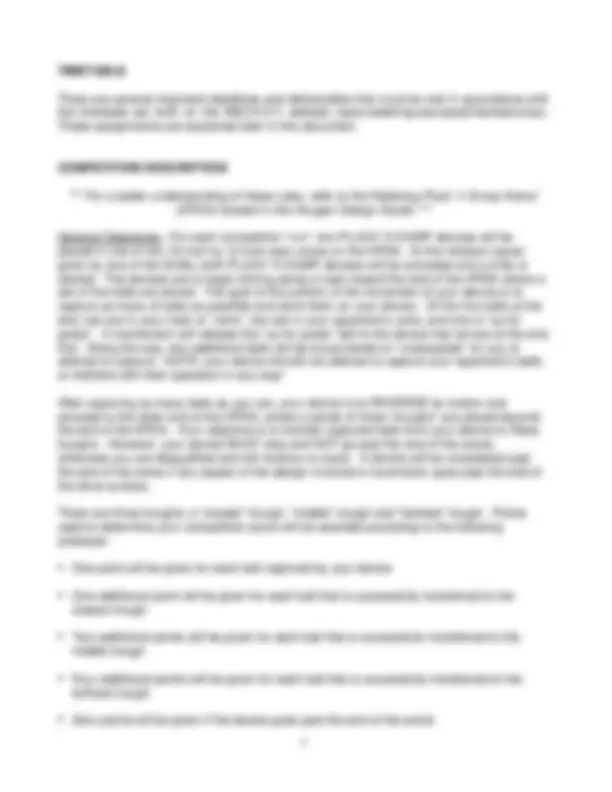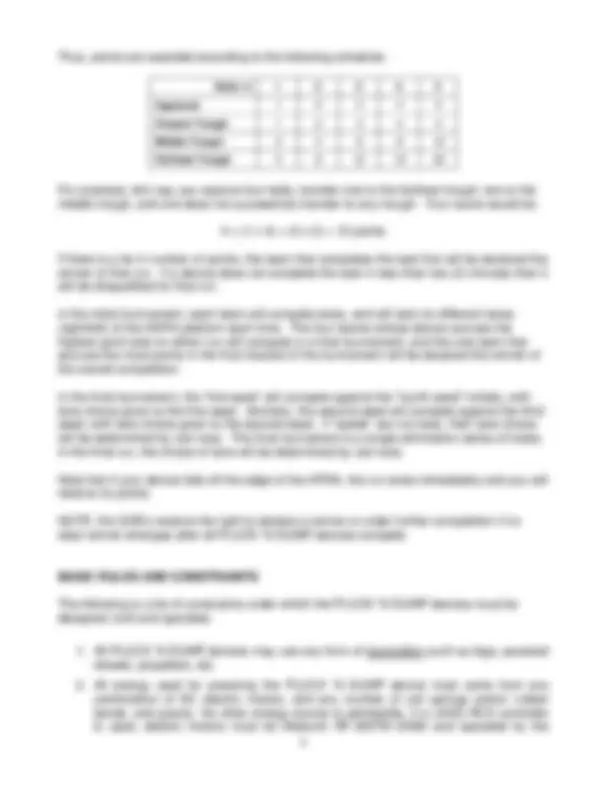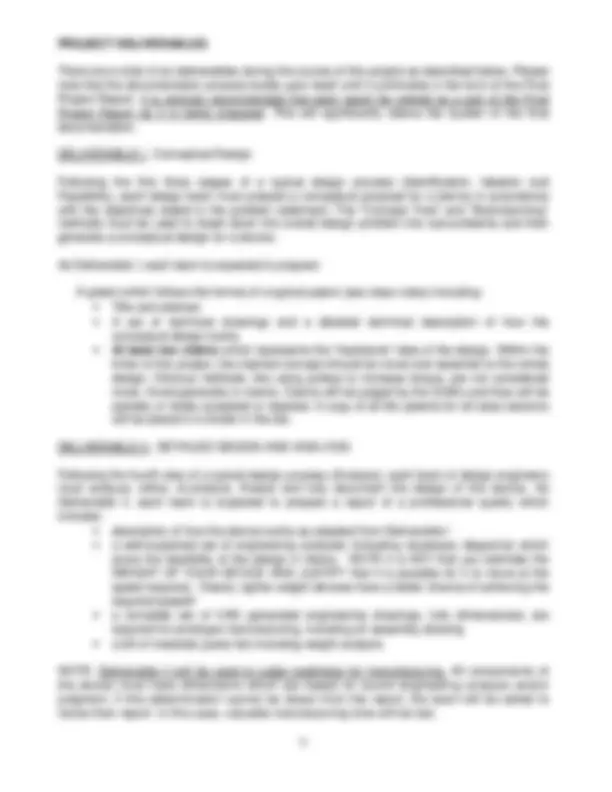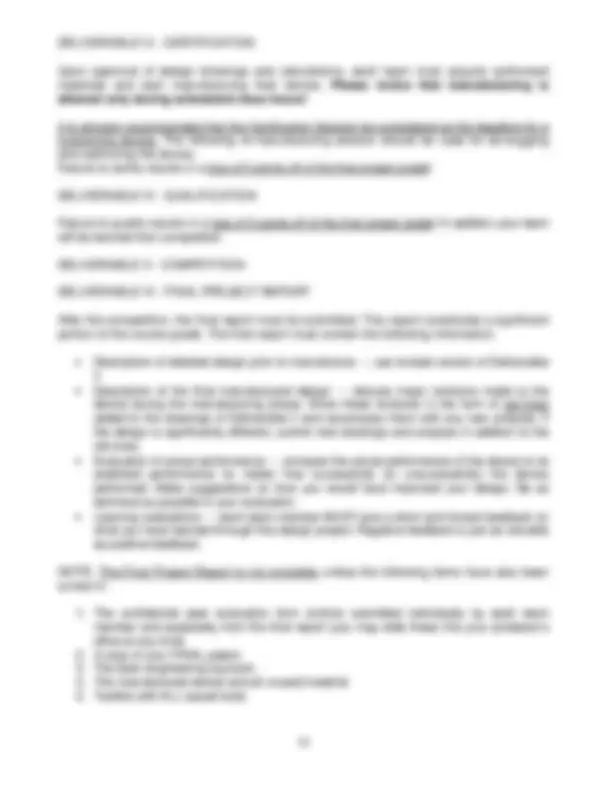








Study with the several resources on Docsity

Earn points by helping other students or get them with a premium plan


Prepare for your exams
Study with the several resources on Docsity

Earn points to download
Earn points by helping other students or get them with a premium plan
Community
Ask the community for help and clear up your study doubts
Discover the best universities in your country according to Docsity users
Free resources
Download our free guides on studying techniques, anxiety management strategies, and thesis advice from Docsity tutors
The philosophy and rules for the mech-311 final project, where students design and build pluck 'n dump devices to capture and transfer balls within a specified arena. The project follows a typical design process, from identification to implementation, with teams recording all aspects of their design experience. Points are awarded based on the number and successful transfer of balls to troughs.
Typology: Study notes
1 / 10

This page cannot be seen from the preview
Don't miss anything!







The basic goal of the MECH-311 final project is to provide a realistic design experience, from concept to completion (including significant time, material, and performance specifications), as a means of practicing the steps and using the tools required by a typical design process.
During the course of this project, design teams are expected to follow the various stages of a typical design process: Identification, Ideation, Feasibility, Analysis, and Implementation (see “Required Reading” on Design Processes). Concept Tree and Brainstorming methods are to be used throughout this project whenever applicable.
IT IS EXPECTED THAT YOU WILL RECORD ALL ASPECTS OF YOUR DESIGN EXPERIENCE (E.G. BRAINSTORMING, ANALYSIS, DETAILED DESIGN, CIRCUITS AND PROGRAMMING NOTES) IN YOUR STUDENT ENGINEERING PROJECT LOGBOOKS.
Student Engineering Project Logbooks are a DAILY summary of your design experience and MUST be presented by all team members daily to the laboratory professor. Team members will SIGN AND DATE the logbook when presenting it to the professor. The logbooks will include a detailed summary of the daily activities in the process of completing your final design, beginning with BRAINSTORMING.
The project will require ingenuity and creativity, as well as analytical ability. It will illustrate the balance between synthesis, analysis, experimentation, creativity, and good judgment. A rigorous time schedule and realistic constraints will be coupled with the accountability aspect of the engineering design profession. Finally, the experience will provide you with examples of the need for good communication, knowledge of the engineering sciences, and the development of an engineering value system.
PROBLEM STATEMENT
You will design a device to compete in an “arena” competition. Your device will participate in a competition that will pit TEAM AGAINST TEAM. The winning team will be the team that out-performs other teams in accordance with the goals, constraints and the performance criteria set forth by this document and as interpreted by the Standards Overview Board members, henceforth known as the SOB’s!
NOTICE: ALL SOB’S MUST APPROVE IN WRITING ANY AND ALL DEVIATIONS FROM THE CONTEST RULES AND PROCEDURES. IT IS EACH TEAM’S RESPONSIBILITY TO OBTAIN DOCUMENTATION OF AUTHORIZED CHANGES. AN INDIVIDUAL SOB’S OPINION AND PERMISSION ARE NOT SUFFICIENT FOR CHANGING OR INTERPRETING THE RULES. ANY REQUEST FOR CHANGE OR INTERPRETATION MUST BE MADE IN WRITING TO THE E-MAIL ADDRESS MECH311@KETTERING.EDU
- NO EXCEPTIONS!
Thus, points are awarded according to the following schedule:
Balls Æ 1 2 3 4 5 Captured^1 2 3 4 Closest Trough 1 2 3 4 5 Middle Trough 2 4 6 8 10 Farthest Trough 4 8 12 16 20
For example, let’s say you capture four balls; transfer one to the farthest trough, two to the middle trough, and one does not successfully transfer to any trough. Your score would be:
4 + (1 x 4) + (2 x 2) = 12 points
If there is a tie in number of points, the team that completes the task first will be declared the winner of that run. If a device does not complete the task in less than two (2) minutes then it will be disqualified for that run.
In the initial tournament, each team will compete twice, and will start on different lanes (right/left) of the KDPA platform each time. The four teams whose device accrues the highest point total on either run will compete in a final tournament, and the one team that accrues the most points in the final bracket of the tournament will be declared the winner of the overall competition.
In the final tournament, the “first seed” will compete against the “fourth seed” initially, with lane choice given to the first seed. Similarly, the second seed will compete against the third seed, with lane choice given to the second seed. If “seeds” are not clear, then lane choice will be determined by coin toss. The final tournament is a single elimination series of heats. In the final run, the choice of lane will be determined by coin toss.
Note that if your device falls off the edge of the KPDA, the run ends immediately and you will receive no points.
NOTE: the SOB’s reserve the right to declare a winner or order further competition if no clear winner emerges after all PLUCK ‘N DUMP devices compete.
The following is a list of constraints under which the PLUCK ‘N DUMP devices must be designed, built and operated.
LEGO Brick controllers. Each team will be supplied six AA batteries for powering the LEGO Brick controllers and/or all other circuits of your device. ANY ADDITIONAL batteries required (to replace low-power batteries) are to be supplied by the design teams. If a LEGO RCX controller is not used, a wider variety of DC motors are available including FF-130 SH, FK-280 PA, RE-260 RA, or RE-280 RA however, whichever motor is chosen must be operated within its designated voltage range.
It is very common for students to try to find that perfect design concept to provide the “competitive edge” over everybody else. Unfortunately, this often means creating a design that uses a loophole in the rules, or circumvents the intended “spirit of the competition”. The SOB’s will not entertain or encourage designs that utilize loopholes or “gray” areas of rules for design intent. This paragraph is meant to state in plain language our vision for “how” competitive devices will work and “how” the competition will be executed:
Our vision is that competition devices will move from the start zone, capture and hold balls available to them on the KPDA, and then move to the trough end of the arena. Upon reaching the trough end of the arena, our vision is that a mechanism designed for the purpose of transferring held balls to the troughs will operate. We do not envision devices where balls are simply “bulldozed” from one end to another. Stopping for strategic reasons is acceptable, but stopping for other reasons is not encouraged. We envision that the devices will move at a speed that suggests an aggressive attempt to complete the competition. In other words, devices should move faster than a lackluster crawl.
The Certification Session is a mandatory session when the teams must show that their PLUCK ‘N DUMP device is functional in the following ways:
Designs will be judged for fitness and safety as per rule 21. Furthermore, at the time of certification, all teams must provide a name for their vehicle!
The qualification is mandatory before a team will be allowed to compete in the final competition. To qualify, each team must show that their PLUCK ‘N DUMP device is functional as shown during certification; also size and weight design requirements must be met. Again, designs will be judged for fitness and safety as per rule 21.
Failure to pass either inspection (Certification or Qualification) based on the SOB’s judgment results in loss of up to 5 points off of the final project grade! During this session, all classes are invited to send spies to each other's sections for determining patent infringements and rule violations.
Again, any charges of rule violations MUST BE brought on or before the qualification date. Under NO CIRCUMSTANCES will anybody be allowed to charge rule violations against another team’s vehicle AFTER qualification.
You are advised to visit the website’s “Q&A Bulletin” link on a daily basis for rules updates and other information: (http://www.kettering.edu/acad/mechatronics/qna.htm)
Table I: Sanctioned Materials MATERIAL SPECIFICATIONS Motors (Mabuchi) see literature Springs (purchase your own if you choose) --- Rubber Bands --- AA Batteries --- Sprockets --- Chain --- Fishing Line or other cord provided in lab --- 1-inch or 1.5-inch dowel 3 in. long = 22.5 gr Switches (to work with the LEGO system only) 0.9 gr Toothpicks --- Sheet Metal, 1" x 4" x 0.023" (^) 8 gr/cm 3
1/4-in wood dowel 6 in. long = 2.35 gr 5/32 & 1/4-in metal dowel --- 1/4-20 UNC All-Thread --- ¼-20 UNC Nut --- Pine Wood (1"x 4"x 12") (^) 0.43 gr/cm 3
1/4” x 12" x 12" wood panel (whatever is available in lab only)
Nails and Screws --- Tape provided in lab --- Paper clips --- Craft Sticks 1.5 gr Wire Coat Hanger --- Paint or any aesthetic coloring (you provide) --- Washers, Bushings, and Hooks --- Adhesives (for fastening only) --- Pop rivets Lead weight (for ballast only) Tygon® tubing (for motor shaft only)
Upon approval of design drawings and calculations, each team must acquire authorized materials and start manufacturing their device. Please notice that manufacturing is allowed only during scheduled class hours!
It is strongly recommended that the Certification Session be considered as the deadline for a functioning device. The following re-manufacturing session should be used for de-bugging and optimizing the device. Failure to certify results in a loss of 5 points off of the final project grade!
DELIVERABLE IV: QUALIFICATION
Failure to qualify results in a loss of 5 points off of the final project grade! In addition your team will be banned from competition.
DELIVERABLE V: COMPETITION
DELIVERABLE VI: FINAL PROJECT REPORT
After the competition, the final report must be submitted. This report constitutes a significant portion of the course grade. The final report must contain the following information:
NOTE: The Final Project Report is not complete unless the following items have also been turned in: